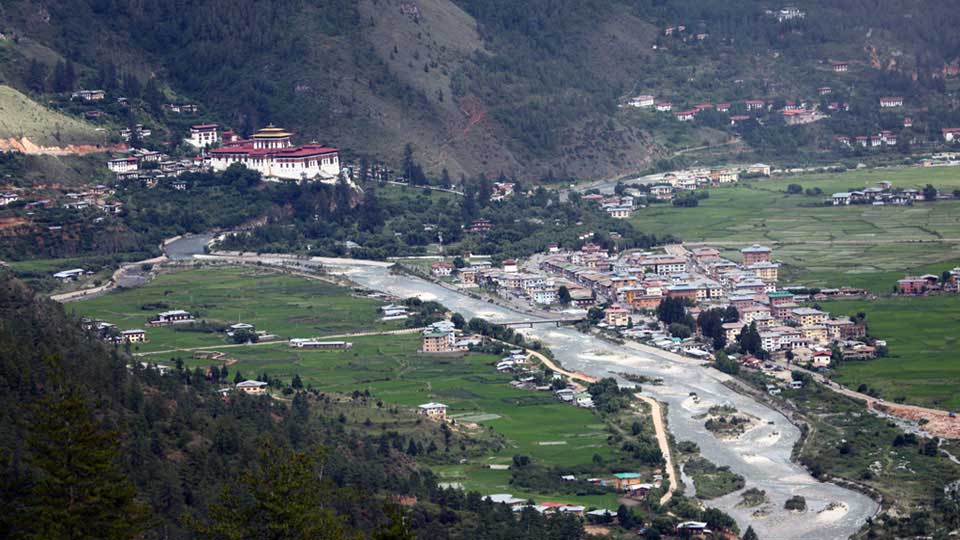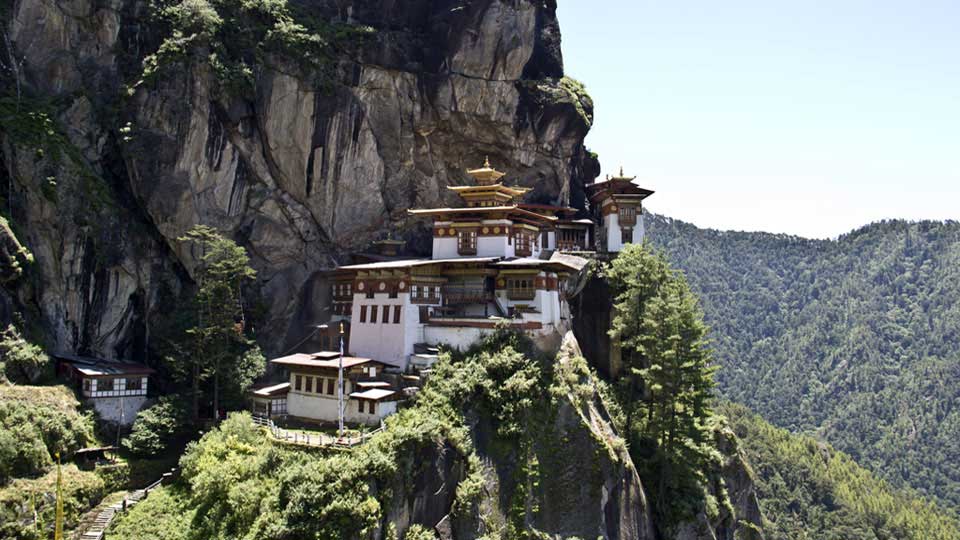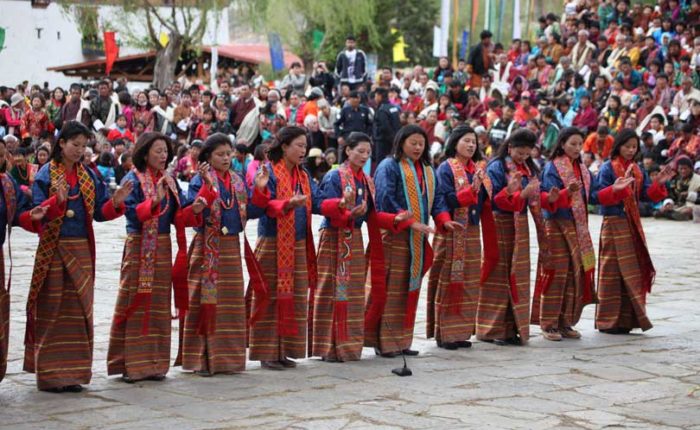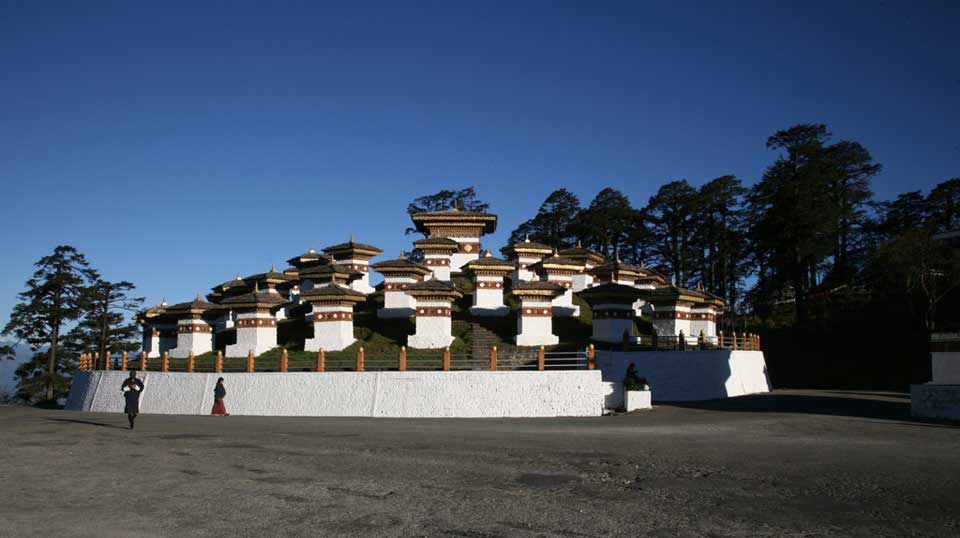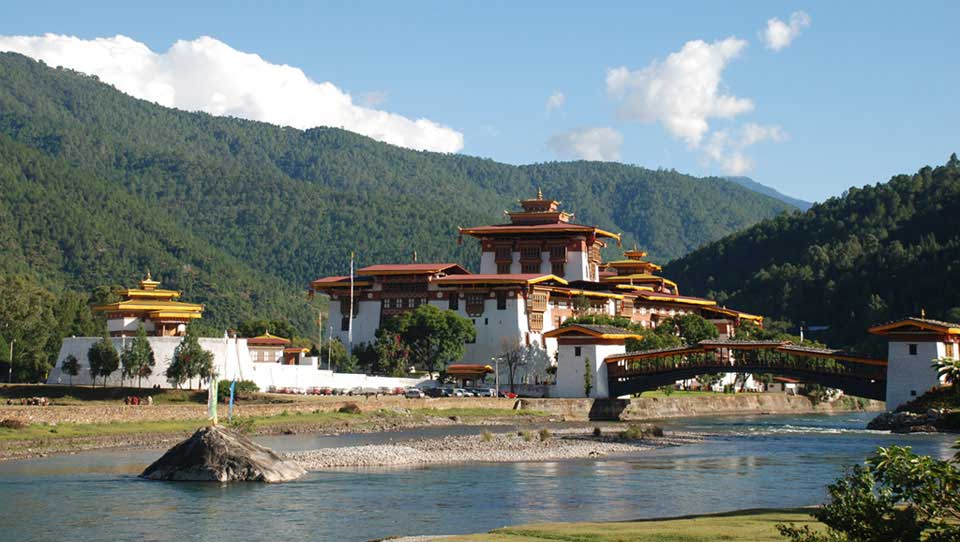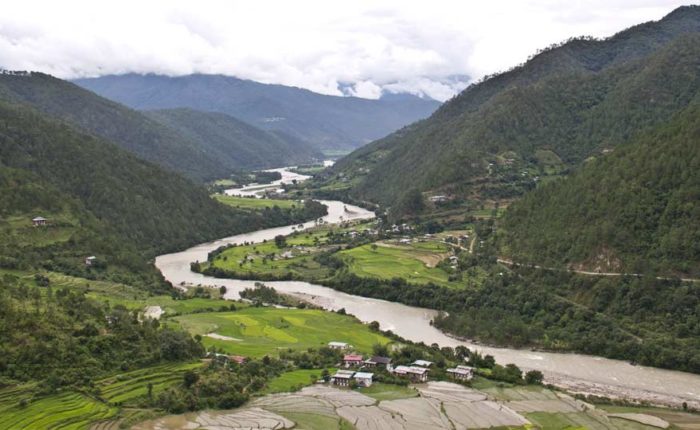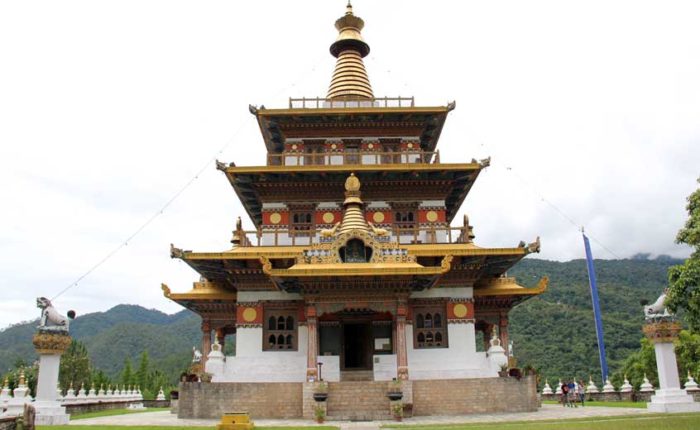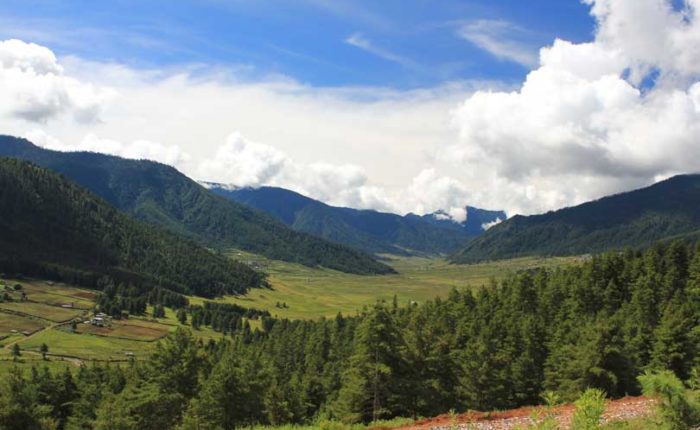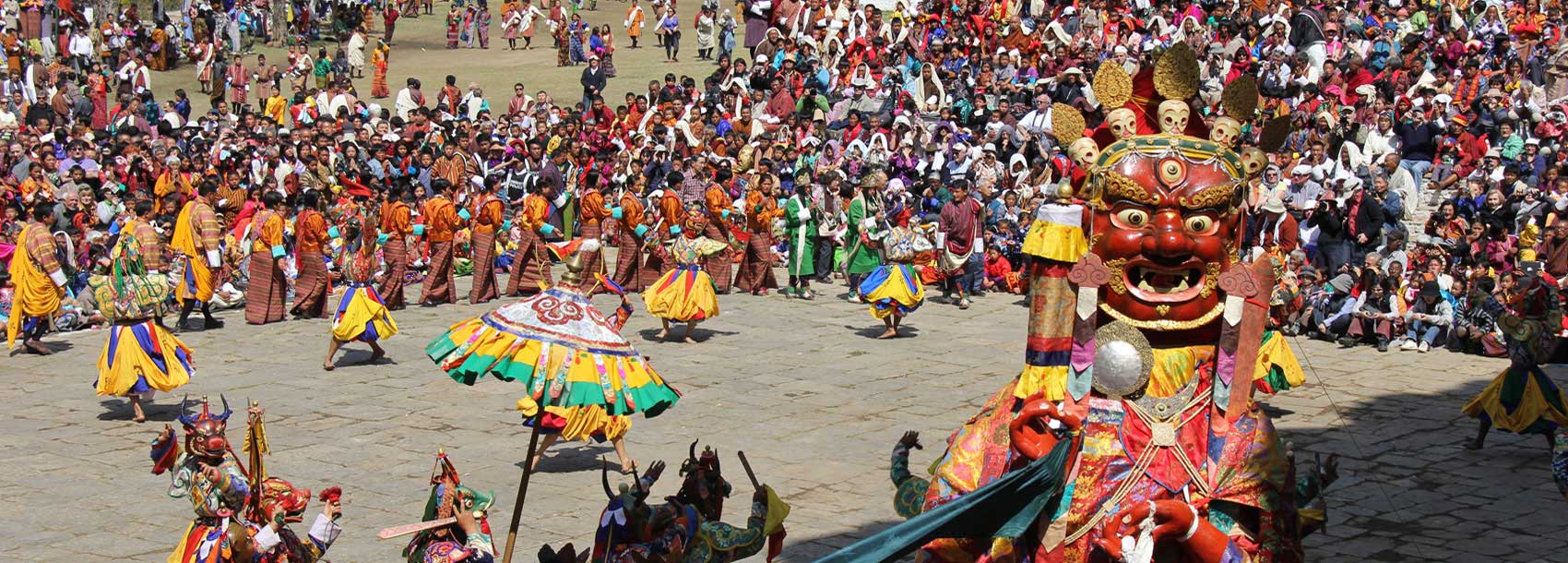
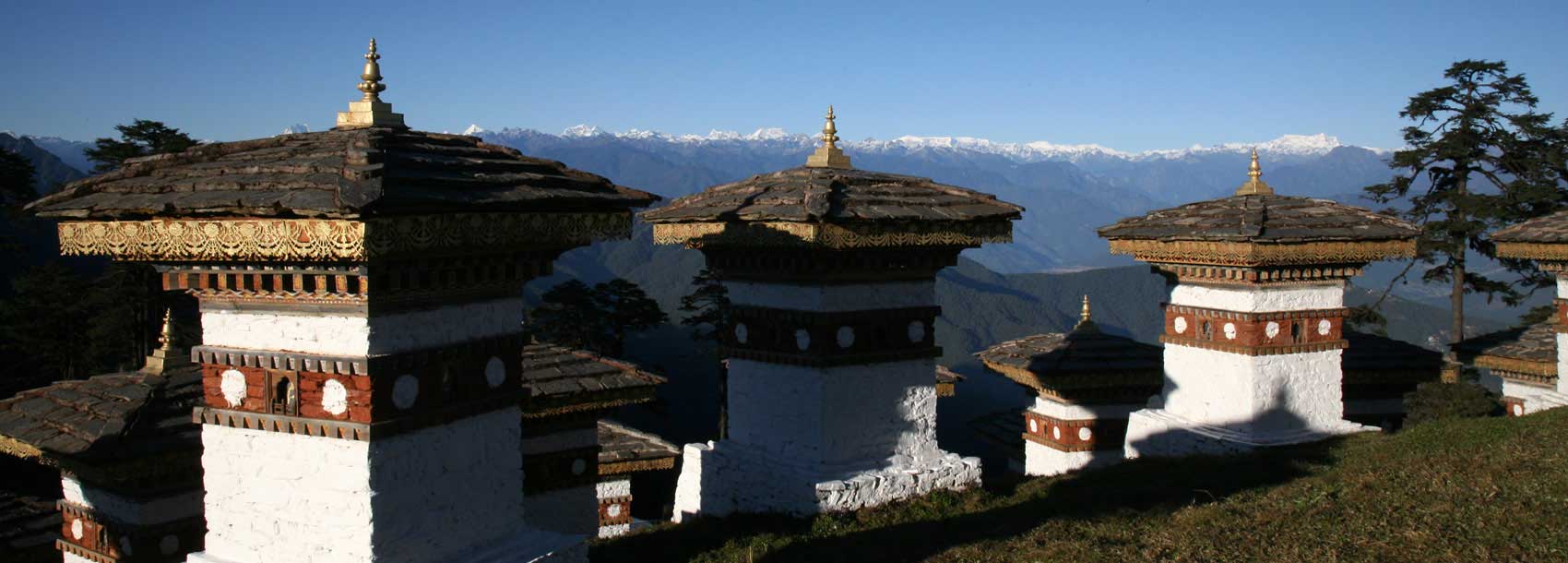
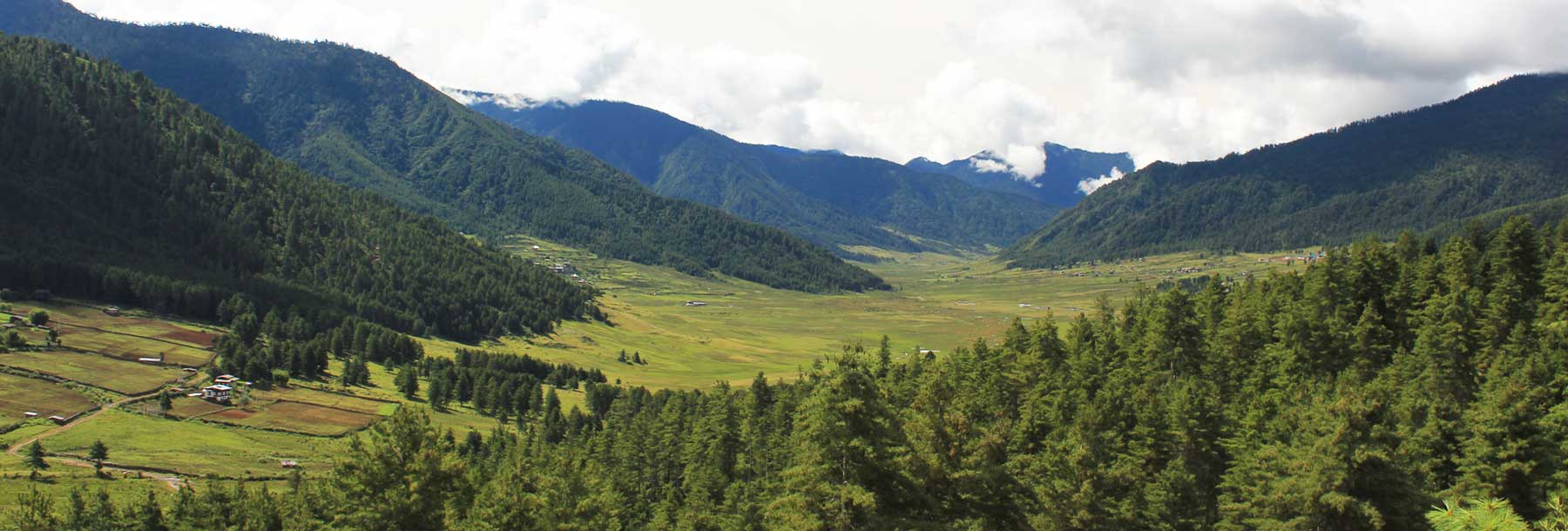
The booking form is highly encrypted and transmitted securely with an SSL protocol.
We will get back to you right away with any applicable discounts and other details including options to pay through direct bank transfer or through our highly secured payment gateway.
Do not hesitate to contact us. We are here to help you plan an amazing trip to Bhutan and will be more than happy to talk to you.
Bhutan – +975-77655137
Thailand – +66-89-494-2064
E-mail us at info@bhutanacorn.com
Fill up contact form
Contact Us
This 8 days 7 nights trip will take you on an enchanted journey through the 4 western districts of Bhutan: Paro, Thimphu, Punakha and Wangdue Phodrang giving you the perfect opportunity to discover the pristine wilderness of the Kingdom of Bhutan, witness a dazzling annual Paro Tshechu festival and encounter fact-to-face with ancient tradition that still flourishes alongside modern development.
Witness the famous annual festival of Paro Tshechu literally means “10th day” as religious festivals usually takes place on the tenth day of a particular month in a yearTshechu where skillful mask dancers perform sacred dances accentuated by beautiful and melodious songs and traditional folk dances. The festival portrays rich cultural heritage of Bhutan and brings the whole community and people from different places together to socialize and foster harmony and happiness.
You will also visit major historical and religious centers including a half-day hike to the most spectacular tourist attraction, Paro Taktsang, which was originally built in 1692. In Phobjikha valley, you will experience a glimpse of life living in the pristine glacial valley and visit one of the historic and largest monastery in Bhutan and meet with compassionate monks.
Paro International Airport, Bhutan
Paro Tshechu Festival takes place from 11th to 15th day of the 2nd month of the Bhutanese Lunar calendar so the corresponding dates on the western calendar changes each year but usually falls during the months of March or April.
For the year 2021, it is scheduled to take place from March 24-28. So you can plan to arrive on March 23, 25, 26 or 27.
High season tariff applies as this tour runs only during March or April.
US$2070 – for single person traveller (Base Price)
3.5% discount – for a couple or group of 2 people
14% discount – for a group of 3-5 people
18% discount – for a group of 6-10 people
20% discount – for a group of 11 people & above
| Paro Altitude | 2,195m/7,200 ft |
|---|
You will take a flight in the morning by either Drukair or Bhutan Airlines and arrive at Paro International Airport. On the way, if the weather is clear enough you will see Great Himalayan mountain ranges. As you enter Bhutanese airspace and soon approach Paro valley, you would already notice the green mountainous landscapes and Paro river snaking down the valley.
After arrival, your visa will be stamped on your passport at the immigration counter. Your guide and driver will receive you at the exit gate of the arrival hall. If your arrival time is way earlier than the hotel check-in time, we will visit one or two places of interest within Paro town. Otherwise, you’ll be heading straight to the hotel. Your guide and driver will assist you to check into the hotel so that you can relax for a while and then have lunch, your first taste of Bhutanese cuisine.
The National Museum of Bhutan is located in Paro just above the Rinpung Dzong (administrative headquarter of Paro district). It is housed in an ancient watch tower called Paro Ta Dzong (Ta Dzong means “watch tower fortress”) built in 1649. It displays hundreds of ancient Bhutanese artifacts and artworks including traditional costumes, armour, weaponry and handcrafted implements for daily life. The collection at the National Museum preserves a snap-shot of the rich cultural traditions of the country. Ta Dzong was converted into the National Museum in 1968.
Kichu Lhakhang (Lhakhang means “temple”), which is located just a few minutes drive from the main town of Paro, is one of the oldest monasteries in Bhutan. It is believed to have been built in 659 A.D. by the Tibetan King Songtsen Gampo.
According to the legend, spirit of a giant demoness lay spread across Tibet and Bhutan causing obstruction to the propagation of Buddhism. In order to subdue this demoness, King Songtsen Gampo was required to built 108 temples across the affected region. Kichu Lhakhang, built to pin down the left foot of the giant demoness, is one of the two temples that were built in Bhutan. The other is called Jampa Lhakhang located in the district of Bumthang in central Bhutan and was built to pin down the left knee. Both the temples were believed to have been built overnight.
The old temple is known as Jowo Lhakhang and holds the original 7th century Jowo Jampa Statue in its inner chapel. Jowo Jampa is a Tibetan term for Buddha Maitreya, the Future Buddha. The outer hall of the Jowo Lhakhang houses the statue of Chenrizig, the God of Compassion Avalokiteshara.
Next to the Jowo Lhakhang is Guru Lhakhang which was built by Her Royal Grandmother Ashi Ashi Kesang Choden Wangchuck in 1971 and houses the statue of Guru Padmasambhava. Inside this temple is also a statue of her spiritual root teacher His Holiness Dilgo Khentse Rinpoche, a highly accomplished Buddhist master who passed away in 1992. Many important religious annual rites are conducted here at Kichu Lhakhang under the patronage of Her Royal Grandmother.
Located about 14km away from Paro main town is Drukgyal Dzong (the fortress of the victorious Drukpa). It is not really known who actually built this Dzong. Some believes it was Zhabdrung Ngawang Namgyel while others say it was Desi Tenzin Drukda, the second administrative ruler of unified Bhutan who built it under the command of Zhabdrung Ngawang Namgyel. But it is a known fact that it was built in 1649 to commemorate victory against the invasion by Tibetan-Mongol forces.
The Dzong was almost completely destroyed by fire in 1951. Some of the main relics including invaluable volumes of sacred Buddhist scriptures were rescued. The dzong used to house one of the largest granaries among all the dzongs in the country. Apart from the sacred Buddhist scriptures, some of the original relics rescued from the fire are an image of Chenrizig, the god of compassion; an image of Zhabdrung Ngawang Namgyal and Dolma (Tara).
The Dzong remained in a ruined state since the devastating fire in 1951. The reconstruction of the Dzong began in 2016 under the command of His Majesty the King and it is expected to take few years before restoring to its former glory.
Leisure time in the town.
Dinner and overnight at the hotel. (Lunch, Dinner)
| Hotels: | ||
|---|---|---|
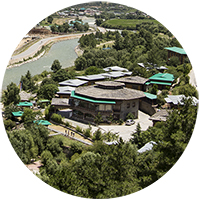 |
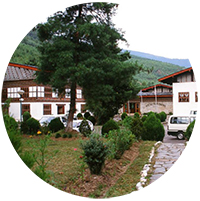 |
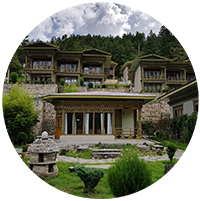 |
Following hearty breakfast, we drive to Paro Rinpung Dzong where the annual Sacred Paro Tshechu takes place. If the day coincides with the main events of the festival which is on the third day, a very auspicious large scroll of embroidered applique known as Thongdrel (literally means ‘liberate at sight’) depicting Guru Padmasambhava will be displayed at the courtyard of the Dzong early in the morning. People get up before dawn and head towards the Dzong to get blessings from Thongdrel.
The spectacular annual festival of Paro Tsechu takes place at Paro Rinpung Dzong (Rinpung Dzong means “fortress of the heap of jewels”). Paro Rinpung Dzong was built by Zhabdrung Ngawang Namgyel in 1646 and established as the administrative and monastic centre of the western region. Today, the Dzong serves as the office of the governor of Paro district and head of the district monk body in Paro.
The annual event of Paro Tshechu is held from the eleventh to the fifteenth day of the second month of the traditional Bhutanese Lunar calendar which usually falls in March or April on the Western calendar.
Tsechus are grand events where entire communities come together to witness sacred mask dances, receive blessings and socialize. In addition to the mask dances, Tsechus also include colorful Bhutanese folk dances and other forms of entertainment.
It is believed that everyone must attend a Tsechu and witness the mask dances at least once in order to receive blessings and wash away their sins. Every mask dance performed during a Tsechu has a special meaning or a story behind it and many are based on stories and incidents from as far back as the 8th century, during the life of Guru Padmasambhava. In monasteries, the mask dances are performed by monks and in remote villages, they are performed jointly by monks and village men.
After watching the Paro Tsechu, take a short walk to the traditional wooden cantilever bridge called Nemey Zampa, where your driver will be waiting for you. The roofed wooden cantilever bridge is built in a traditional style and this type of bridges are called Bazam.
Leisure time in the town
Dinner and overnight in Paro. (Breakfast, Lunch, Dinner)
| Hotels: | ||
|---|---|---|
 |
 |
 |
After early breakfast, you will checkout from the hotel because by the time we come back from today’s excursion, it will be way past the checkout time. You will hike to Paro Taktsang and in the late afternoon we will drive to Thimphu, the capital city of Bhutan.
| Total Hiking Time | 4 hours |
|---|---|
| Taktsang Altitude | 3,120m/10,235ft |
Right after checking out from the hotel, we will drive to the base of the Taktsang monastery from where the hike begins. Taktsang monastery is located on a sheer 800-meter rocky cliff in Paro. It normally takes about 2 hours to reach the monastery from the nearest road point. It is the most popular tourist attraction in Bhutan. After an hour of steep uphill hiking on the ancient trails shaded by pine trees, you’will reach a nice cafeteria from where you can see spectacular view of the Taktsang monastery. Hot tea and snacks will be served here. For those of you who are still energetic, can hike further up for 1 hour and visit the monastery and enjoy grand views of the Paro valley below.
Taktsang, or the Tiger’s Lair (people prefer to call Tiger’s Nest), is regarded as one of the most important monasteries in Bhutan. Its history is associated with the visit of Guru Padmasambhava (known as Guru Rinpoche), the Indian saint who came to Bhutan and introduced Tantric Buddhism in the 8th century A.D. It is believed that Guru Padmasambhava flew into the cave from Kurtoe Singye Dzong in eastern Bhutan, riding on a tigress.
Taktsang is not only a sacred site visited by Guru Rinpoche but was also visited and blessed by many other renowned Buddhist masters; Langchen Pelgi Singye – one of the 25 disciples of Guru Rinpoche in the 8th century, Jitsun Milarepa – famous 11th century yogi, Phajo Drugom Zhigpo – 13th century saint who brought Drukpa school of Tibetan Buddism to Bhutan, Zhabdrung Ngawang Namgyel – the founder of nation-state of Bhutan in the 17th century, Desi Tenzin Rabgay – the fourth administrative ruler of unified Bhutan in the 17th century.
It was the fourth temporal ruler of unified Bhutan, Desi Tenzin Rabgay, who built Taktsang monastery in 1694. However, the present monastery you see today is not the original structure. It was destroyed by fire in 1998. His Majesty Jigme Singye Wangchuck, the fourth King initiated and personally supervised the reconstruction of Taktsang monastery to its former glory. It was completed and consecrated in 2005.
Inside one of the temple is a Choeten, a Buddhist stupa built in memory of Langchen Pelgi Singye and holds his sacred body relic. It is believed that the Choeten fulfill wishes if you pray with pure devotion.
Lunch at Taktsang Cafeteria
After lunch at the picturesque Taktsang Cafeteria, we hike downhill back to the base where your driver will be waiting for you. From there we will drive to Thimphu.
| Distance | 55km |
|---|---|
| Transportation | SUV/Minivan/Bus |
| Time | 1.5 hours |
| Thimphu Altitude | 2,334m/7,655ft |
It is a 55km road journey and the drive should not take more than one and half hour. We will be driving along the Paro River (Pa Chhu) which runs until the confluence (Chhuzom) where it is joined by Thimphu River (Thim Chhu). The two rivers form Wang Chhu and flows southward and is the major river running two hydroelectric power plants. After Chhuzom the road follows Thim Chhu river upstream and as you pass through number of villages, you will already feel immersed in a wonderland surrounded by mountains and beautiful landscapes.
If interested, you can stopover on the way to visit Tamchog Lhakhang, a temple that is dedicated to the 15th century Tibetan saint Thangthong Gyalpo popularly know as the iron bridge builder. It is located across the Pachhu river along the Paro – Thimphu highway. To visit the temple you will have to cross an iron chain bridge over the Pachu river, one of the very few remaining of the many iron chain bridges built by Thangthong Gyalpo.
This is a private temple owned by the direct descendants of Thangtong Gyalpo. However, tourists are allowed to visit if they are given permission. Crossing this very old bridge with its swaying and undulating movements can be quite an experience. The temple’s location on the ridge and the high rocky barren hills which serve as it’s backdrop makes this a good location to take pictures.
Upon arrival in Thimphu, our guide will assist you to check into the hotel. If we are able to reach Thimphu between 5pm – 6pm, you might want to visit Tashichho Dzong which opens to visitors after 5PM during working days and 9am – 5pm on weekends.
Tashichho DzongDzong means Fortress in national language of Bhutan, Dzongkha, which means “Fortress of the Glorious Religion” is opened to visitors only after 5PM during working days and from 9AM to 5PM on weekends. The original Dzong, known as Dho Ngon Dzong was built in 1216 A.D. by Lama Gyalwa Lhanangpa on a location where Dechen Phodrang monastery stands today. It was acquired by Zhabdrung Ngawang NamgyelZhabdrung Ngawang Namgyel was a Tibetan Buddhist master who came to Bhutan in 1616 and unified Bhutan as a nation state in 1641 and renamed it as Tashichho Dzong. The original Dzong was destroyed by fire in 1771 and then relocated to the present location. The Dzong suffered several earthquakes and fires and was subsequently renovated and new structures added by successive rulers.
It was His Late Majesty King Jigme Dorji Wangchuck who renovated and enlarged the entire Dzong to its present form in 1962 over the period of six years. The magnificent architectural feat was achieved using traditional method without any blueprint plans or nails. It houses the Secretariat and offices of the King, the Throne Room, Ministry of Home and Cultural Affairs, Ministry of Finance and Central Monastic Body.
Overnight at hotel in Thimphu. (Breakfast, Lunch, Dinner)
| Hotels: | ||
|---|---|---|
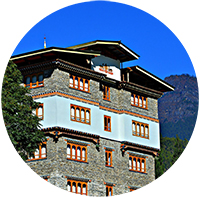 |
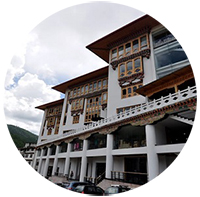 |
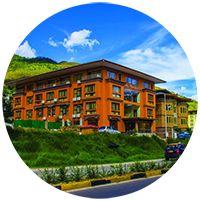 |
| Thimphu Altitude | 2,334m/7,655ft |
|---|
Today on your fourth day, you will spend whole day exploring some of the most popular tourist attractions in Thimphu, the capital city of Bhutan. Thimphu is home to a population of about 100,000 and it is the only capital city in the world where you will not see traffic lights and billboards. Thimphu’s altitude is 2,334 meters above sea level.
After early breakfast, you will begin the day by first visiting the most frequented religious sites in Thimphu, the National Memorial Choeten. The National Memorial Choeten is a Buddhist Stupa built in 1974 in memory of the Late Third King Jigme Dorji Wangchuck who passed away in 1972. It is one of the important landmarks in Thimphu. People from all walks of life come here to pray and circumambulate and it is a good opportunity for you to observe how Bhutanese people devote themselves to daily prayers and take refuge in the teachings of the Lord Buddha.
The marvelous 169 feet tall bronze statue of Lord Buddha is located on a hilltop, Kuensel Phodrang, overlooking the Thimphu valley. From here you can see a nice view of Thimphu city. It was built to celebrate the 60th birth anniversary of the Fourth King His Majesty Jigme Singye Wangchuck and also for the purpose of bringing peace in the world . The giant Buddha statue houses more than 100,000 8-inch tall Buddha statues of same type. The construction began in 2006 and was completed in 2015 after almost 10 years. The total cost of the entire project is well over US$100 million.
Bhutan Post Office which is located in the heart of the city in the same building as Bhutan National Bank so you can also exchange your money into local currency if you wish.
The Postal Service in Bhutan was first launched in 1962 with the opening of a post office in Phuentsholing, a town in the south bordering with India. The Postal Museum was opened in 2015 to exhibit the story of Bhutan’s progress and development of communications and postal system in the country. If you are interested in philatelic products and stamp collection, they have a good collection of stamps, First Day Covers and stamp albums.
Located in the capital city of Thimphu, this museum was established in 2001 and provides visitors and tourists with fascinating insights into the Bhutanese material culture and way of life. The Folk Heritage Museum is set inside a three storied, 19th century traditional house.
The museum gives you a glimpse of the traditional Bhutanese lifestyle, in addition to artifacts from rural households, it also displays an impressive collection of typical household objects, tools and equipment. In an effort to maintain our knowledge of indigenous natural resources, native trees and plants that had domestic uses in a rural Bhutanese household is grown at the front yard of the museum, creating an oasis of greenery, right in the heart of the capital city of Thimphu.
The museum also has a restaurant with traditional setting and ambience where a buffet lunch or dinner consisting of traditional dishes are offered. However, lunch and dinner arrangement is only available for a group of five or more people.
Lunch at the Folk Heritage Museum if your group size is five or more people. Otherwise, it will be arranged at one of the fine restaurants in the town.
Note: The Folk Heritage Museum is closed on government holidays. Hours of operation are from 10am to 4:30pm on weekdays; from 10:30am to 1pm on Saturdays and 11:30am to 3:30pm on Sundays.
After lunch, we will visit The National Institute of Zorig Chusum (Zorig Chusum means 13 Traditional Arts & Crafts) which is located nearby the Folk Heritage Museum. The National Institute of Zorig Chuzum was established to promote and preserve the thirteen traditional arts and crafts of Bhutan and to facilitate increased access in learning Zorig means “Arts and Crafts”Zorig skills by Bhutanese youths. Many of these traditional arts and crafts are declining with the advent of modern technologies and therefore, the government is putting in lot of effort to train youths to keep the traditions alive.
The thirteen arts and crafts are categorized as:
Shing Zo (woodwork)
Dho Zo (stonework)
Par Zo (carving)
Lha Zo (painting)
Jim Zo (sculpting)
Lug Zo (casting)
Shag Zo (wood turning)
Gar Zo (blacksmith)
Troe Zo (ornament making)
Tsa Zo (bamboo work)
De Zo (paper making)
Tsem Zo (tailoring, embroidery and applique)
Thag Zo (weaving)
These thirteen arts and crafts are an essential part of Bhutan’s cultural heritage that have been practiced from time immemorial. These arts were formally categorized during the reign of Gyalse Tenzin Rabgay, the fourth temporal ruler of Bhutan in the 17th century.
If the class is in session when you arrive, you will be allowed to enter the classroom and observe students as they get hands-on training.
Thangtong Dewachen Nunnery is a Buddhist nunnery popularly known as Anim Dratsang which is located in Zilukha overlooking Tashichho Dzong and is just a few minutes drive from the National Institute of Zorig Chusum. It was built in 1976.
The main statue inside the nunnery is of Dupthop Thangtong Gyalpo, a Tibetan saint who came to Bhutan in 1433. He was widely known as Chakzampa Thangtong Gyalpo (Chakzampa means “iron bridge builder”) and was famous for building many Iron Chain Bridges in Tibet and Bhutan.
With a small monetary donation, if you wish, you can request nuns to perform prayer ceremony for your spiritual well-being and to clear obstacles on your path. The nunnery sustains on voluntary donations made by the visitors.
Weaving is an integral component of the culture and tradition of Bhutan. With rapid development and exposure to the western culture, the art of weaving and production of its own handwoven textile is declining fast. To preserve and promote this living art, Her Majesty Queen Mother Sangay Choden Wanchuck established the Royal Textile Academy of Bhutan in 2005 as a non-profit organization. Given the important role it plays in preserving and promoting our unique culture and tradition, The Royal Textile Academy was registered as a Civil Society Organization in 2011.
The Textile Museum showcases collection of artifacts to impart understanding of Bhutan’s rich textile traditions and way of life. The Museum consists of two galleries – The upper gallery which has a permanent display of the various types of textile weaves in the country and the lower gallery that displays temporary exhibitions on special themes.
Handicraft Emporium is located in the main town which is run by the National Women’s Association of Bhutan. It is a one-stop souvenir shop where you will find wide range of Bhutanese Handicrafts and handwoven Bhutanese attires. This souvenir emporium is one of the few shops accepting major credit cards.
Leisure time in the town.
Overnight at a hotel in Thimphu. (Breakfast, Lunch, Dinner)
| Hotels: | ||
|---|---|---|
 |
 |
 |
| Distance | 74km |
|---|---|
| Transportation | SUV/Minivan/Bus |
| Time | 3 hours |
| Punakha Altitude | 1,200m/3,935ft |
Today on the fifth day, after early breakfast, we will drive to Punakha Valley via beautiful Dochu La Pass. From Thimphu to Punakha, it is a 74km road journey which should not take more than 3 hours under normal road condition. We will do 2 hour return hike to Khamsum Yulley Namgyel Choeten and visit the historic Punakha Dzong.
About 45 min drive from Thimphu towards Punakha is a mountain pass at an altitude of 3,150 meters above sea level from where you can see, on a clear day, some of the highest peaks of Bhutan. Before the construction of these beautiful 108 Druk Wangyal Choetens (stupas) in 2004, this mountain pass remained only as a sacred place blessed by a famous Buddhist saint, Lam Drukpa Kuenley in late 15th century. Her Majesty Grand Queen mother Dorji Wangmo Wangchuck built these 108 stupas in memory of the fallen soldiers in a 2003 battle which was personally led by our Fourth King, His Majesty Jigme Singye Wangchuck, against ULFA/BODO militants from neighbouring Indian state of Assam who camped illegally inside Bhutanese territory along the southern belt and refused to leave the country peacefully. There is also a temple called Druk Wangyal Lhakhang (temple) on a nearby hilltop built in honour of His Majesty the Fourth King. The past and future appears to merge in the details of the lhakhang (temple) and its structure tells the story of a supreme warrior figure, whose vision pierces the distant future in a fine blend of history and mythology. There is a nice cafeteria from where you can relax and view the surrounding mountains.
From Dochula Pass, we will continue driving towards Punakha, passing through some villages, the elevation drops gradually and the road winds through the pine trees. As you reach the lower valley, you will feel the drastic change in altitude from 3,150m just an hour and a half ago to 1,200m.
Arrive at the hotel in Punakha. Your guide and driver will assist you to check into hotel and relax before lunch is served.
After lunch, you will be going for 2 hour return hike to Khamsum Yuelley Namgyel Choeten. Located on a ridge overlooking the picturesque Punakha valley, this wonderful Buddhist structure is a fine example of Bhutanese architecture used in building temples, monasteries and Zangdogpelri (copper coloured mountains). It was built over a period of almost 10 years under the command of Ashi Tshering Yangdon Wangchuck, one of the Grand Queen Mothers of Bhutan and was consecrated in 1999.
It takes only about 20 minutes drive from the main town of Punakha to the nearest road point. From there you cross a suspension bridge over the Punakha Mochu River (female river) and the trail takes you through paddy fields. Normally it takes just under one hour to reach the serene site of the marvelous choeten. The view below is stunning with glacial fed Mochu river snaking through the fertile valley of Punakha.
The Punakha Dzong, originally known as Pungthang Dechen Phodrang, meaning the “Palace of Great Bliss”, was built in 1637 A.D. by Zhabdrung Ngawang Namgyel (Tibetan Buddhist master who came to Bhutan in 1616 and founded nation-state of Bhutan) on a small stretch of land where the rivers Phochu and Mochu converge. Punakha Dzong is the second oldest and second largest Dzong in Bhutan. The Dzong served as the administrative centre and the seat of the Government of Bhutan until 1955, when the capital was shifted to Thimphu. Punakha Dzong displays exquisite and intricate Bhutanese architecture and it is the most beautiful dzong in Bhutan.
Today, it serves as the office of the governor and head of the monk body in Punakha district. It is also the winter residence of the Chief Abbot of Bhutan, Je Khenpo. During the winter months from November to April, the Je Khenpo along with the central monk body moves from Thimphu and resides in Punakha Dzong and moves back to Thimphu Tashichho Dzong during the summer. This tradition of maintaining a summer and winter residence was first introduced by Zhabdrung Ngawang Namgyel himself in the 17th century and the tradition is still practiced to this day.
A great annual festival called Punakha Tsechu dedicated to Guru Padmasambhava (the saint who brought Buddhism to Bhutan in the 8th century A.D.) and Zhabdrung Ngawang Namgyel is held at the Dzong. Punakha Tsechu or religious festival is conducted from the tenth day of the first month of the traditional Bhutanese Lunar calendar which usually falls sometime during the month of February or March on the western calendar. People from far flung villages and other districts come to attend the sacred festival.
Leisure time in the town.
Overnight at a hotel in Punakha. (Breakfast, Lunch, Dinner)
| Hotels: | ||
|---|---|---|
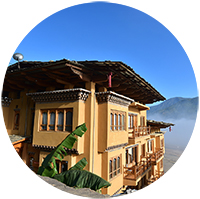 |
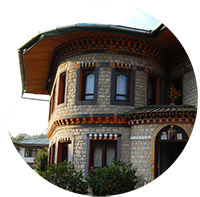 |
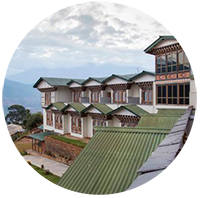 |
| Distance | 80km |
|---|---|
| Transportation | SUV/Minivan/Bus |
| Time | 3 hours |
| Phobjikha Altitude | 3,000m/9,840ft |
Today on the 6th day, we will drive to Phobjikha valley and on the way visit Chime Lhakhang and briefly stop at Wangdue Phodrang Dzong. Driving distance from Punakha to Phobjikha is around 80km and takes approximately 3 hours under normal road condition.
After breakfast, we start our journey towards the valley of Phobjikha. We will stop below Lobesa and do a 20 – 30 minutes walk to the famous temple called Chime Lhakhang through terraced paddy fields and farm houses.
Chime Lhakhang is located on a gentle hilltop near the village of Sopsokha. The site offers a panoramic view of the Punatsangchu river and Wandue Phodrang town.
Lama Drukpa Kuenley built a small black stupa on this hilltop to mark the burial site of demons whom he managed to subdue after chasing all the way from Dochula Pass, where the demons were terrorizing the travellers. This black stupa can be seen even today just outside of the main temple. It was Lama Ngawang Chogyel, the younger brother of Lama Drukpa Kuenley, who built the present temple in 1499 A.D.
Lama Drukpa Kuenley was a Tibetan Buddhist Master who travelled extensively in western and central Bhutan exercising his holy powers to subdue devils and liberate people from suffering during the late 15th century and early 16th century A.D. He was known as “Divine Madman” for his obscene behavior and outrageous ways of cleansing people from religious dogmatism and egoistic self-possession by exhibiting his strong desire for sex. He would often use his desire, emotion, and sexuality to arouse disillusionment, insight and delight in all he encountered. He would often use phallus as a tool to subdue malevolent spirits. Using the phallus was also intended to free up the social inhibitions enforced by the socially established values.
Today, one of the relics of Chime Lhakhang is a phallus. The blessing of the phallus is considered sacred particularly to women who are unable to conceive a child as it brings fertility to women, giving them ability to bear offspring. Because of this belief, people like to call Chhime Lhakhang as “Temple of Fertility”.
Married couples who are unable to conceive a child often come to this temple seeking blessings from the Divine Madman. As much as it sounds ‘too good to be true’, there are many stories of happy couples who are blessed with child after visiting the temple.
The Wangdue Phodrang Dzong, third oldest Dzong in Bhutan was built in 1638 and stood majestically on the hilltop. The original Dzong which was one of the most important and historic heritage sites in Bhutan was burnt down by the tragic fire accident on 24 June 2012. Under the guidance of His Majesty the King and His Majesty the Fourth Druk Gyalpo, all the precious sacred artifacts and objects inside the main temple of the Dzong were saved and there was no human casualty.
Currently the Dzong is under reconstruction which started from January 2014 and it is expected to take until the end of 2018 to rebuild to its former glory incorporating state-of-the-art technology in terms of disaster resilience measures and traditional architecture.
From Wangdue Phodrang town, the drive on the lateral national highway connecting western and eastern region will gradually ascend up the pristine mountains of Bhutan and eventually enter the most beautiful valley in Bhutan, Phobjikha.
Phobjikha is a vast U-shaped glacial valley at an elevation of about 3,000m/9,840ft and it is a winter home for endangered Black Necked Crane from November to March and migrates back to Tibet by the beginning of spring season. Researchers have confirmed that the same birds which migrates here in winter goes as far back as Mongolia in summer. Every year on the 11th of November, Black Necked Crane Festival is held to celebrate the arrival of this endangered and majestic bird which becomes an inseparable part in the lives of the local people during winter months.
One very famous landmark in this valley is the 17th century Gangtey Monastery popularly know as Gangtey Goenpa literally means “remote place” and is usually a place of religious significanceGoenpa (goenpa literally means “remote place” and is usually a place of religious significance). The monastery was founded in 1613 by Pema Thinley, the grandson of Pema Lingpa, the great treasure discoverer from the valley of Bumthang in central Bhutan. The name Gangtey is derived from the fact that the goenpa is built on a peak (Tey) of a hillock (Gang). Pema Thinley served as the first Gangtey Trulku means “reincarnation”Trulku. The monastery was later expanded by the second Gangtey Trulku Tenzin Legpai Dhendup (1645-1726) and today it is one of the biggest monasteries in Bhutan. The present abbot of this monastery is the ninth Gangtey Trulku His Holiness Kunzang Rigzin Pema Namgyal. The monastery also has a monastic college where hundreds of monks study Buddhist philosophy for 9 years.
An annual religious festival, Gantey Tshechu, is held at Gangtey Goenpa during autumn when the harvest season is just over. A series of dazzling sacred mask dances complemented by Bhutanese folk dances are performed during this festival.
After lunch, you can either relax, take a leisure walk in the valley and visit the Black Necked Crane Information Center, which has a lot of information on the migratory bird and about the valley and its role in conservation of Black Necked Crane. For nature enthusiasts and those who enjoy long walk through the woods surrounded by splendid nature all around, taking up Gangtey Nature Trail is highly recommended. The trail is about 5km and takes approximately 3 hours. It gives you a great feeling of the Phobjikha valley and ample opportunities to take beautiful pictures.
You have a choice to put up yourself in a hotel or grab an unusual opportunity to stay at a farmhouse with a local family and get a glimpse of typical village life in Bhutan. If you still have some muscle sore hangover from your hike to Taktsang and Khamsum Yulley Namgyel Choeten, you can soak up in a traditional hot stone bath later in the evening and lighten up with a cup of locally brewed liquor “Ara”. You may have to pay extra for the hot stone bath.
Overnight in Phobjikha valley. (Breakfast, Lunch, Dinner)
| Hotels: | ||
|---|---|---|
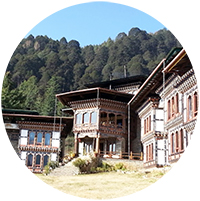 |
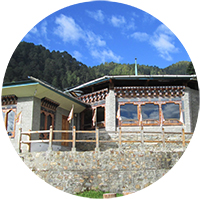 |
|
| Distance | 188km |
|---|---|
| Transportation | SUV/Minivan/Bus |
| Time | 6 hours |
| Paro Altitude | 2,195m/7,200ft |
Today, on the 7th day of your trip, we will drive back to Paro valley via the same way we came – Wangdue Phodrang, Lobesa, Dochula Pass and Thimphu. On the way, if time permits, visit the first and oldest Dzong built by Zhabdrung Ngawang Namgyel in the 17th century A.D.
After driving for about 130km, we will stop at the outskirt of Thimphu and visit Simtokha Dzong which is built strategically on a ridge overlooking the Thimphu valley. The Simtokha Dzong is significant not only because it was the first Dzong built by Zhangdrung Ngawang Namgyel but also stands on the borders of three major regions: Thimphu, Paro and Wangdue Phodrang. Zhabdrung Ngawang Namgyel built this Dzong in 1631 to consolidate his rule over the western Bhutan. Simtokha Dzong is considered as the oldest Dzong in Bhutan.
One of the main statues inside the Simtokha Dzong is the statue of Buddha of Compassion. Legend has it that fortunate visitors are able to see a light shining forth from the chest of the Buddha. The Dzong has more than three hundred slate carvings from the 17th century. Recently, His Majesty the 5th King donated statue of Zhabdrung Ngawang Namgyel which wasn’t there initially.
We will continue to drive towards Paro, on arrival check into hotel and relax before your last dinner of the trip is served.
Overnight at a hotel in Paro. (Breakfast, Lunch, Dinner)
| Hotels: | ||
|---|---|---|
 |
 |
 |
After breakfast, you will be transferred to the Paro Internatioal Airport for your onward journey. Your guide will assist you to complete all exit formalities before you check-in.
(Breakfast)
All tour services we provide are independent with flexible itineraries which can be customized to suit your interest and requirement. You can form a group to get discounts. Apart from the predesigned packages which have proven successful, Bhutan Acorn Tours & Travel can also arrange the following add-on activities to enrich your experiences in Bhutan. These activities can be fitted into any tour itineraries.
Please note that some of the activities may involve extra fees.
All your deposits and any payment less administrative fees of US$100 per person will be refunded if you notify us at least 30 days prior to your arrival date. Refer the cancellation fee schedule below to determine the applicable charges:
| DAYS TO ARRIVAL | CANCELLATION CHARGES PER PERSON |
|---|---|
| 30+ | US$100 administrative fee per person |
| 16-29 | 20% of the total cost |
| 8-15 | 50% of the total cost |
| 0-7 days | No refund is available |
In case the trip is cut short or duration lost due to unforeseen reasons after arrival in Bhutan, no refund is available as the payment would have been already made to hotels and other logistics.
There shall be no charges for the number of days of delay either during arrivals or departures or both, due to weather conditions, communication problems, cancellation or delay in Bhutanese airline flights, sickness or any other legitimate reason as Tourism Council of Bhutan (TCB) may deem reasonable. However, the Tourist will be charged on the actual expenses on accommodation, food, transport and any other services provided.
